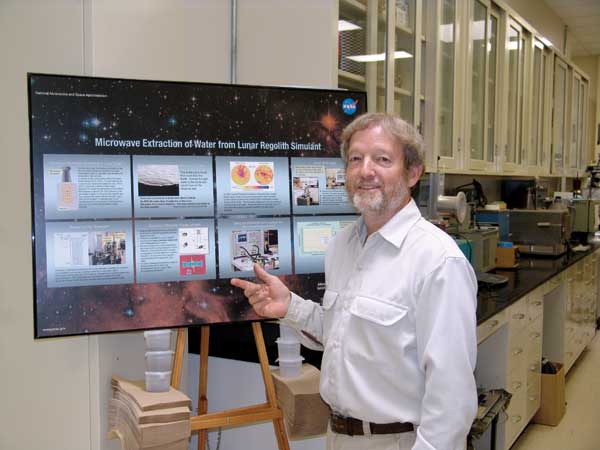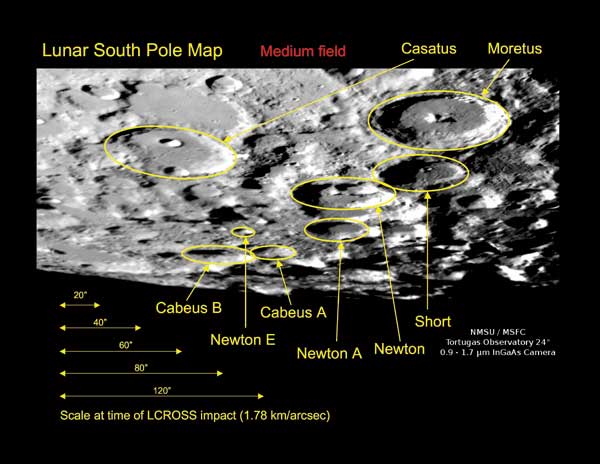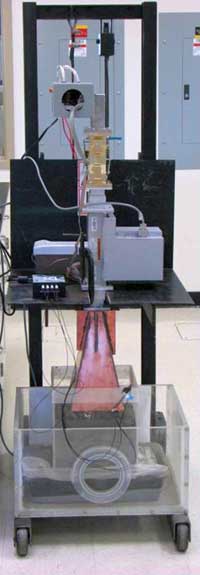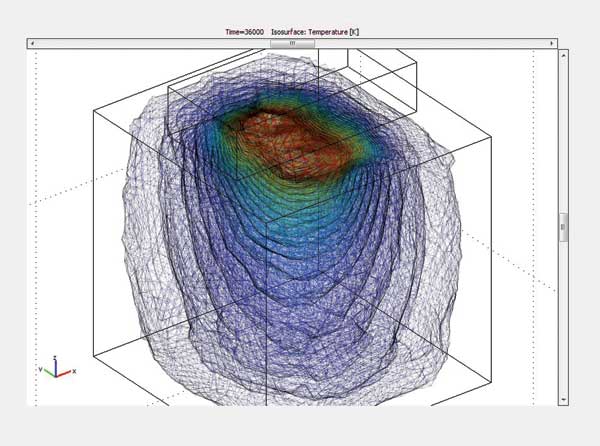Latest News
May 11, 2011
By Cathleen Lambertson
In 1999, NASA’s Lunar Prospector revealed concentrated hydrogen signatures detected in permanently shadowed craters at the lunar poles. While scientists have long speculated about the source of vast quantities of hydrogen at the poles, recent discoveries made by NASA’s Lunar CRater Observing and Sensing Satellite (LCROSS) are shedding new light on the question of water on the moon.

Dr. Edwin Ethridge showcases the water extraction process.
Preliminary data from LCROSS indicates that the mission successfully uncovered water during the Oct. 9, 2009 impacts into the permanently shadowed region of the Cabeus crater near the moon’s south pole. These findings could have far-reaching implications, as space exploration is being expanded past low-Earth orbit.
The Importance of Moon Water
Water and other compounds found on the moon represent potential resources that could sustain future lunar exploration. According to Dr. Edwin Ethridge, a materials scientist in the Materials & Processes Laboratory at NASA Marshall Space Flight Center in Huntsville, AL, in situ resources are important because they do not have to be launched out of Earth’s gravitational well.
“It is very expensive to get mass into space,” he explains. “The weight of a payload that goes into space is only a very small fraction of the total rocket weight on the launch pad.”
For example, it costs around $50,000 per pound to launch anything to the moon. The cost of getting the payload into orbit is the total cost of the rocket, rocket hardware, engines and propellant. And because water is one of the resources that will have to be resupplied to a manned lunar outpost, water would be part of the total cost of the payload taken to the moon.
While water and oxygen can be recycled on a manned lunar outpost, no process is 100% efficient. Ethridge cited estimates indicating that 1 ton of water and 1 ton of oxygen per year would be required for the early stages of a manned outpost. This fact alone makes it necessary that a water extraction process will be developed for use at an outpost. Once the water is extracted, oxygen can be obtained from the water by electrolysis.
“We are looking at the process of extracting the water from the soil,” he explains. “Water is water. Run it through a purification system and you could drink it. We will extract water ]and then] electrolysis can be used to split the water into hydrogen and oxygen.”

Figure 1. Labeled composite image of the South Pole taken by New Mexico State University/Marshall Space Flight Center, using the Tortugas 24-in. telescope. (Photo courtesy of NMSU/MSFC)
The Extraction Process
As a principal investigator examining the use of microwaves for the extraction of volatiles from lunar soil, Ethridge asserts that microwave processing to extract water has unique advantages over other processes.
 Figure 2. Demonstration hardware to test the beaming of microwave energy down into lunar soil simulant (in the box), with the microwave hardware mounted on a mobile platform. Initial test of the coupling of microwave energy into the simulant. |
“Because of the high vacuum, the thermal conductivity of lunar soil is very low,” he says. “The Apollo astronauts measured the thermal conductivity, and it is comparable to aerogel, a super thermal insulator.”
Additionally, microwave energy is advantageous because it heats from the inside out. This means that the excavation of lunar soil could be unnecessary, thereby minimizing moon dust and the negative aspect of perhaps having to strip-mine the moon. Simply put, using microwaves could greatly reduce the complexity, additional infrastructure, resources and power requirements of other processes. This is why Ethridge is currently developing microwave extraction technology for operation on the moon.
The basic components of the microwave extraction system include a microwave source, waveguides to deliver the energy to the soil, and a cold trap to capture the water vapor (see Figure 2). First, the microwave energy penetrates and heats the soil. Because ice is relatively transparent to microwave energy, heat is transferred from the soil particles to the water ice condensed onto the surface of the soil. On the moon, water ice transforms directly to water vapor by sublimation. Once in the cold trap, the water vapor will transform back to ice. In addition to the system components, a power source and a rover to transport the extraction system will be necessary.
Simulating the Moon
Because the microwave processing parameters and hardware requirements for water extraction is a complex multi-physics problem, Ethridge employed simulation to address the challenges.
“When I wrote the proposal for the microwave extraction of water, the COMSOL calculations were part of the originally proposed work,” he says.
COMSOL is being used to calculate the microwave penetration into and heating of simulated lunar soil. The properties of the simulant are approximated by complex electric permittivity and magnetic permeability measured in the lab.
“Calculations can be performed on different geometries, for a range of microwave frequencies and different power levels, for the simulated lunar soil,” says Ethridge. “Since the temperature varies with time as the soil heats, temperature-dependent soil di-electric properties can be incorporated into the model, along with temperature-dependent thermal conductivity of the soil. Whatever the properties of the lunar soil might be, we can simply put them into COMSOL and do a calculation.”
For the simulation, Ethridge used the RF Module to model the microwave power penetration and attenuation into the soil (see Figure 3). When the model was running without error, the physics of heating and heat flow were added. A transient analysis was used to determine heating as a function of time. An AVI movie is available that shows lines of constant temperature as the heating progresses.
“Development of an early experiment payload for a lunar lander mission requires the specification of the microwave frequency, power, and method of delivery of power,” Ethridge states. “Developing experiments with several different microwave frequencies would require a significant investment of resources, manpower and time to perform experiments. COMSOL permits the calculation of microwave penetration and heating that could be expected with different experiment scenarios. This can reduce the time, labor and cost to narrow the hardware requirements for the experiment.”
The next step for Ethridge is to develop a model of the percolation of water vapor from the soil. Currently, the Southern Research Institute in Birmingham, AL, is measuring the Darcy constant (describing the flow of a fluid through a porous medium) for lunar soil simulant. Once the data is generated, a model of the water vapor transport from the simulant will be developed.

Figure 3.Transient solution of the penetration of microwave energy (0.5 GHz) into lunar soil stimulant with heating of the soil. Colors represent constant temperature isotherms. The AVI movie shows the progressive heating of the soil over a period of 10 hours. Watch the movie.
For More Info
COMSOL
Subscribe to our FREE magazine, FREE email newsletters or both!
Latest News
About the Author
DE’s editors contribute news and new product announcements to Digital Engineering.
Press releases may be sent to them via [email protected].
Related Topics






